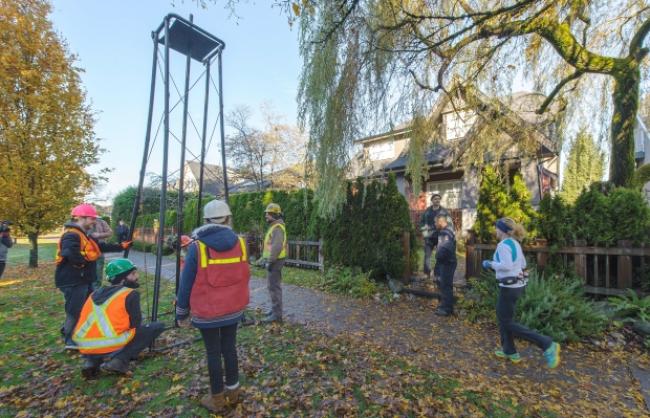Articles Menu

Protesters erected a 15-foot fracking rig last November in front of B.C. Premier Christy Clark’s Vancouver home. A new report, set to be published in the journal of the Seismological Society of America, examines an area straddling the B.C.-Alberta border and finds that between 90 and 95 per cent of seismic activity Magnitude 3 or larger in the last five years was caused by activity connected to hydraulic fracturing, widely known as "fracking."
A new report, set to be published in the journal of the Seismological Society of America, examines an area straddling the B.C.-Alberta border and finds that between 90 and 95 per cent of seismic activity Magnitude 3 or larger in the last five years was caused by oil and gas activity, with most of it linked to hydraulic fracturing, or “fracking.”
"The biggest implication of this study is that we can no longer deny the link between induced earthquakes and hydraulic fracturing," said Honn Kao, an earthquake seismologist with the Geological Survey of Canada and co-author of the report. Asked if more work is needed to better understand the link between seismic activity and resource extraction in Western Canada, Kao said: "The answer is definitely yes.
"We now know much more about induced seismicity than four years ago when our research project started. But we still have a long way to go before we can claim that the phenomenon is well-understood," said Kao, a B.C.-based scientist with Natural Resources Canada, a federal government institution. "Ultimately, we hope that our research results can provide observation-based results to regulators so that a good balance can be reached between the protection of public safety and environment, and the economic benefit of developing unconventional oil and gas resources," he said.
The process of hydraulic fracturing, or "fracking," uses highpressure injections of water, sand and chemicals to break apart rock and release oil and natural gas trapped underground.
For the report, in the May-June edition of Seismological Research Letters, the team of 13 scientists surveyed seismic activity between 1985 and 2015 in the Western Canada Sedimentary Basin (WCSB), an area of 454,000 square kilometres near the border between Alberta and B.C., and looked at 12,289 fracking wells and 1,236 waste-water disposal wells.
Another co-author of the report was Dan Walker, senior petroleum geologist with the B.C. Oil Gas Commission. Walker wasn't available to speak Monday, but BCOGC spokesman Graham Currie answered questions by email, saying: "The B.C. Oil and Gas Commission has taken a leading role in the detection and mitigation of induced seismicity."
The report's lead author, Western University professor of geophysics Gail M. Atkinson, said it's important to note that earthquakes triggered by fracking are localized within a few kilometres of drilling sites, which are usually in remote locations of the province, and people living in B.C.'s cities and towns aren't at risk.
Above photo: Ward Perrin , PNG